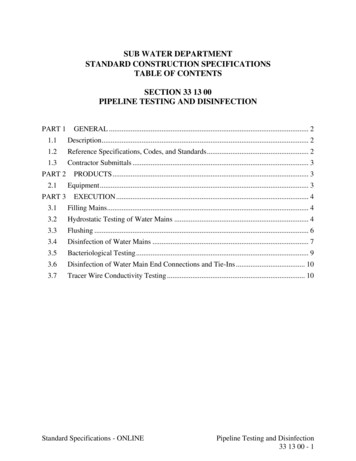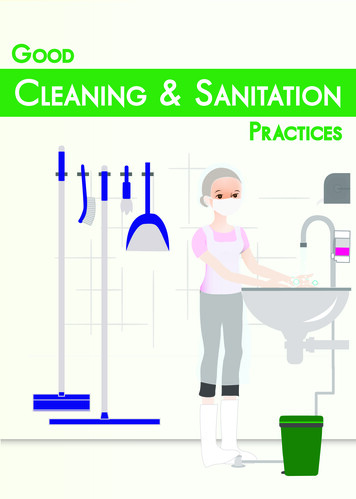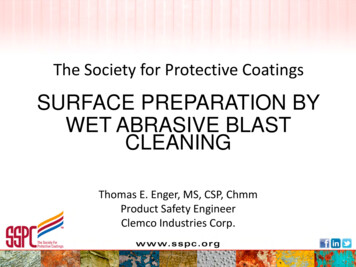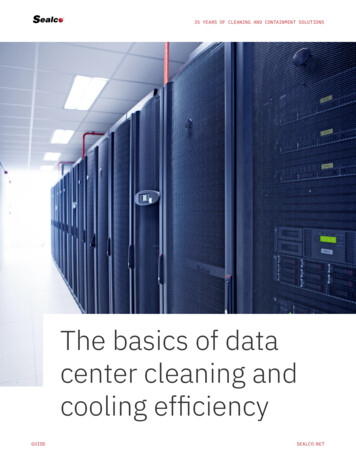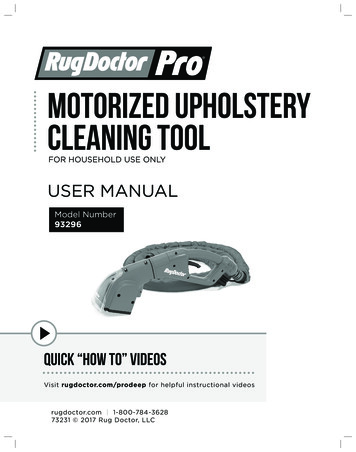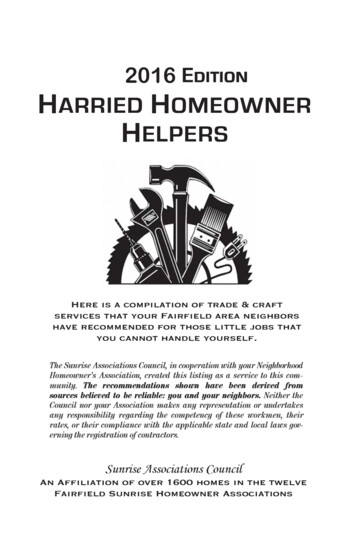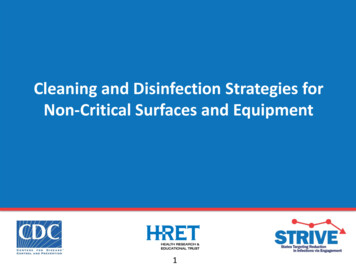
Transcription
Cleaning and Disinfection Strategies forNon-Critical Surfaces and Equipment1
PresenterDan Bennett, CHESP, M-CHEST, T-CHESTManager, Environmental ServicesSt. Joseph’s Hospital-NorthContributions byDavid P. Calfee, MD, MSWeill Cornell Medical CollegeRuth Carrico, PhD, FSHEA, RN, CICUniversity of Louisville School of MedicineAssociation for the Health Care Environment2
Learning ObjectivesOutline activities that constitute appropriate cleaningand disinfection in healthcare settingsExplain special circumstances that may requireheightened disinfectionDescribe components of an effective competencybased training program for environmental services staffDiscuss auditing strategies to measure effectiveness ofcleaning practices3
Role of Environmental Services inInfection PreventionImprovement in cleaning and disinfection practices canprevent pathogen transmissionEnvironmental services team plays a central role in lowand intermediate-level disinfectionCleaning and disinfection is a critical component of anyinfection prevention program4
Daily Cleaning and DisinfectionPer your facility’s policy, follow the manufacturer label’s instruction forproper disinfection product use(Practice Guidance for Healthcare Environmental Cleaning, 2nd Edition, AHA, 2012; Rutala WA, CDC, 2008)5
Daily Cleaning and DisinfectionFollow label’s instruction for proper disinfection product useClean and Disinfect all surfaces. This includes horizontal, vertical andcontact surfacesDisinfect all “high-touch” surfaces daily and upon discharge Cleaned surfaces should remainwet and air dry per the label’sinstruction Clean floors on a regular basis,when spills occur and whenvisibly soiled(Practice Guidance for Healthcare Environmental Cleaning, 2nd Edition, AHA, 2012; Rutala WA, CDC, 2008)6
Daily Cleaning and DisinfectionPlan a logical cleaning pattern to be followedthat accounts for room variationRestroom should always be cleaned lastFollow guidelines for an optimal cleaning path– For example: clockwise, top to bottom– Cleanest to dirtiestChange cleaning cloths frequentlyClean walls, blinds and window curtains whenthey are visibly contaminated or soiledChange microfiber mop after each room, afterisolation room and after cleaning blood andbodily fluid spills(Practice Guidance for Healthcare Environmental Cleaning, 2nd Edition, AHA, 2012; Rutala WA, CDC, 2008)7
Special Isolation ProceduresLow- or intermediate-level disinfectants are specific to the type ofisolationConsider potential contamination of privacy curtainsDo not bring equipment carts into isolation roomsOnly leave the room when cleaning is completedRemove PPE before leaving the patient environmentImmediately perform hand hygieneDisinfect cleaning equipment and return to the cart(Practice Guidance for Healthcare Environmental Cleaning, 2nd Edition, AHA, 2012; Trillis F, InfectControl Hosp Epidemiol, 2008; Rutala WA, Am J Infect Control, 2014)8
Use of “No-Touch” Method TechnologyUltraviolet light (UV)– Reliable biocidal activity against a wide range of healthcareassociated pathogens– Residual-free– Useful for disinfection room surfaces and equipmentHydrogen peroxide— Reliable biocidal activity against a wide range ofhealthcare-associated pathogens— Residual-free— Aeration unit converts hydrogen peroxide intooxygen and water— Useful for disinfection complex equipment and furnitureBoth may pose occupational safety concerns if not used properly.(Rutala WA, Am J Infect Control, 2014)9
Daily Cleaning Sheets and ChecklistsEnsures all room surfacesare cleaned and disinfecteddailyEnsures all areas of thehospital are cleaned daily10
Responsibility of Equipment Cleaning Non-Critical Equipment:– Infusion pumps Collaborative effort todetermine responsibility forcleaning of non-criticalequipment– Sequential compressiondevice pumps Staff should be trained onwho is responsible forcleaning equipment and howand when cleaning shouldoccur– Glucometers– Blood pressure monitors– Mobile computers andworkstations– Tablets or smartphone– Ventilators11
Non-Critical EquipmentUse dedicated disposable devices when availableIf a dedicated, disposable device is not available, disinfect all noncritical patient care equipment before removing the device from theroom and before using it with another patientDisinfect non-critical medical devices with an EPA-registered hospitaldisinfectant following the label’s instructions Assure staff responsible for devicecleaning receive training on cleaningprocedures that follow the equipmentmanufacturer’s instructions(Rutala WA, CDC, 2008)12
Competency-Based Training forEnvironmental ServicesNew Hire Competency Assessments Training and RetrainingClassroom training, with written quizzesConduct trainings and administerwritten exams at monthly meetingPreceptor trainingDeliver trainings for team membersthat fail auditsObservation of PPE donning and doffingNew policy implementationObservation of daily cleaningReview necessary cleaning proceduresat daily huddlesObservation of discharge cleaningReview competencies tested duringnew hire training annuallyObservation of C. difficile isolation discharge13
Maintaining Competency throughAnnual AssessmentsAnnual Competency Checks– Successful attendance at monthly training and pass written exams– Pass PPE donning and doffing observed by management– Pass three observed cleanings by management Daily cleaning Discharge cleaning C. difficile discharge Isolation cleaningCertification for Healthcare Environmental Services Technician,– e.g. CHEST– Offered by Association for Healthcare Environment (AHE)– Frontline staff certification– Complete required training– Pass certification exam14
Auditing the Effectiveness of CleaningVisual assessment: is not a reliable indicator of surfacecleanlinessDirect observation: measures individuals’ adherence toprocessesFluorescent marker: determines if a particular area was wiped ATP bioluminescence: measures actively growingmicroorganisms through detection of adenosine triphosphate(ATP)― Each unit has own reading scale, 250-500 RLU(Cooper RA, Am J Infect Control, 2007)15
What to Test(Guh A, CDC, 2010)Available at: lCleaning-Checklist-10-6-2010.pdf16
SummaryFollow best practices for environmental disinfectionProperly train and educate environmental service technicianson proper cleaning and disinfection processesHave nursing, respiratory therapists, infection preventionistsand environmental services agree upon a list of equipmentthat are to be cleaned and disinfected by Nursing and byEnvironmental ServicesAudit cleaning and disinfection practices and providefeedback to environmental services technicians to ensureproper disinfection of surfaces17
ReferencesCooper RA, Griffith CJ, Malik RE, et al. Monitoring the effectiveness of cleaning in four Britishhospitals. Am J Infect Control. 2007; 35(5): 338–41.Guh A, Carling P, Environmental Evaluation Workgroup. Options for evaluating environmentalcleaning. Centers for Disease Control and Prevention. 2010. Available eaning-Eval-Toolkit12-2-2010.pdf. Accessed onSeptember 23, 2016.Practice guidance for healthcare environmental cleaning, second edition. Association for HealthcareEnvironment. Chicago: American Hospital Association, 2012.Rutala WA, Gergen MF, Sickbert-Bennett EE, et al. Effectiveness of improved hydrogen peroxide indecontaminating privacy curtains contaminated with multidrug-resistant pathogens. Am J InfectControl. 2014; 42(4): 426–8.Rutala WA, Weber DJ. Disinfectants used for environmental disinfection and new roomdecontamination technology. Am J Infect Control. 2013; 41(5 Suppl): S36-41.Rutala WA, Weber DJ, Healthcare Infection Control Practices Advisory Committee. Guideline fordisinfection and sterilization in healthcare facilities, 2008. Centers for Disease Control and Prevention.2008. Available at tion Nov 2008.pdf.Trillis F 3rd, Eckstein EC, Budavich R, et al. Contamination of hospital curtains with healthcareassociated pathogens. Infect Control Hosp Epidemiol. 2008; 29(110): 1074–76.18
Speaker Notes19
Speaker Notes: Slide 1Hello, and welcome to the second module EnvironmentalCleaning course. This module, entitled Cleaning and DisinfectionStrategies for Non-Critical Surfaces and Equipment, will providean overview of strategies to consider when trainingenvironmental services technicians about cleaning anddisinfection policies and procedures, and to identify tools toassist with monitoring and auditing practices.20
Speaker Notes: Slide 2This module was developed by national infection preventionexperts devoted to improving patient safety and infectionprevention efforts.21
Speaker Notes: Slide 3After completing this module you will be able to: Outline activities that constitute appropriate cleaning anddisinfection in healthcare settings; Explain special circumstances that may require heighteneddisinfection ; Describe components of an effective competency-basedtraining program for environmental services staff; and Discuss auditing strategies to measure effectiveness of cleaningpractices.22
Speaker Notes: Slide 4As we discussed in module one, cleaning and disinfection of thepatient care environment is an important aspect of preventingtransmission of microbes that can lead to patient and staff harm.The environmental services team plays an essential role inensuring that low-level and intermediate disinfection isperformed properly.For this module we will focus on recommended cleaning anddisinfection processes that, when performed by environmentalservices technicians, provides a critical component of anyinfection prevention program.23
Speaker Notes: Slide 5To begin, let’s discuss daily practices that should be followed forcleaning and disinfection. Cleaning and disinfection, as a onestep process, use a disinfectant detergent that doesn’t requirepre-cleaning of surfaces unless grossly contaminated or if a spilloccurred. You should recall from the first module onenvironmental cleaning and disinfection that there are differentlevels of disinfectants. Low level disinfection kills most vegetativebacteria, some viruses, and some fungi, but cannot be reliedupon to kill mycobacteria or bacterial spores.24
Speaker Notes: Slide 5 ContinuedIntermediate level disinfection kills vegetative bacteria, mostviruses and most fungi, but does not reliably kill bacterial spores.High level disinfection, often referred to as HLD, completelyeliminates all microorganisms except for small numbers ofbacterial spores. The environmental services technician shouldselect the level of disinfectant required per their hospital’spolicy. All disinfectants should be used according to themanufacturer’s label instructions.25
Speaker Notes: Slide 6Manufacturer’s label instructions indicated dilution, contact time(the time it should remain wet), surface compatibility and othersafe use instructions. For both daily cleaning and dischargecleaning, all surfaces should be cleaned and disinfected with adamp wiped with a microfiber or disposable cloth saturated withthe disinfectant-detergent solution. The diagram on the slidehighlights common “high-touch” surfaces the environmentalservices technician should pay special attention to, focusing onthese areas and the surfaces that are in the immediate vicinity ofthe patient. This may include the bedrail, the over bed table andcall button to name a few.26
Speaker Notes: Slide 6 ContinuedEnvironmental services management, in conjunction with theinfection control team, should determine what surfaces yourhospital considers “high-touch” as it can vary from facility tofacility. These and other surfaces should remain wet for theamount of time specified on the label’s instructions. Floorsshould also be cleaned on a regular basis, when spills occur, andwhen they are visibly soiled.27
Speaker Notes: Slide 7Environmental leadership should plan a consistent pattern staffshould follow to maintain quality and adherence amongtechnicians. Environmental services technicians should follow thatcleaning path to ensure nothing in the room is skipped. Cleaningshould always occur cleanest to dirtiest, with the restroom alwayscleaned last to reduce the likelihood of spreading contamination.On this slide we have an example of what a cleaning path mightlook like. Cleaning cloths should be replaced after every room andfrequently while cleaning the room; typically five to seven clothsare used per room. And remember, if you are using the bucketsystem, do not place the cleaning cloth back into the disinfectantsolution after using it to wipe a surface.28
Speaker Notes: Slide 7 ContinuedWalls, window blinds and privacy curtains in patient areas shouldbe cleaned when they are visibly soiled, and on a regularschedule determined by the environmental servicesmanagement and infection control team. For mopping floors it isrecommended to use microfiber mops and to change the mophead after each room including, after isolation room cleaningand after cleaning blood or bodily fluid spills. Now that we havea reviewed the daily cleaning and disinfection practices, let’s talkabout some special considerations when cleaning an isolationroom.29
Speaker Notes: Slide 8When performing cleaning for an isolation room, follow thesame procedures as used for a regular room cleaning. Inaddition, you will need to follow a few more detailed steps. First,don appropriate personal protective equipment (PPE) for theparticular isolation precaution before entering the room andcheck for proper fit. To review PPE use for transmission-basedprecautions, you can review the modules on PPE.30
Speaker Notes: Slide 8 ContinuedYou will need to use specific disinfectant for the type of isolation,for example, quaternary ammonium compounds are oftenrecommended for multidrug-resistant organisms (MDROs) suchas methicillin-resistant Staphylococcus aureus, MRSA, andvancomycin-resistant enterococcus, VRE, while sodiumhypochlorite or an Environmental Protection Agency (EPA)registered sporicidal disinfectant is recommended to kill Cdifficile spores. Remember to follow your hospital’s policy on useof bleach for patient settings contaminated with C. difficile.Some organisms may require an EPA-registered disinfectantlabeled as a tuberculocidal.31
Speaker Notes: Slide 8 ContinuedIt’s important to remember to clean and disinfect patient privacycurtains in isolation rooms. Privacy curtains have shown to becontaminated, and a study by Trillis in 2008 demonstrated thatcurtains can be a source of pathogens on healthcare providers’hands. Rutala and colleagues recommend cleaning the grab areawith an improved hydrogen peroxide (1.4 percent) productsprayed three times from six to eight inches away. They foundthat this practice reduced contamination of MDROs by over 90percent. For rooms under C. difficile isolation remove the curtainand properly launder it prior to re-hanging the curtain.Equipment carts should not be brought into isolation rooms.32
Speaker Notes: Slide 8 ContinuedOnce the technician begins cleaning an isolation room, theyshould only leave that room when the cleaning is completed or ifrequested by a nurse or doctor. Proper PPE removal is critical toavoid pathogen contamination and transmission outside of theroom. Avoid touching the outside of your PPE, as infectiousorganisms may have settled there, and follow proper doffingtechnique before leaving the patient environment. If thetechnician is wearing a respirator or powered-air purifyingrespirator (PAPR), remove it after leaving the room andimmediately perform hand hygiene.33
Speaker Notes: Slide 8 ContinuedOnce the technician has removed their PPE and performed handhygiene, the technician must don new gloves and clean anyenvironmental cleaning equipment that was used in the room,including wiping down the mop handle, before returning to theequipment cart and moving on to the next task.34
Speaker Notes: Slide 9It is important for environmental services team to collaboratewith infection control to stay current on new cleaning anddisinfection processes, including new technology. Several new“no-touch” technologies have been developed over the past fewyears. Two of the most common no-touch systems used areultraviolet light (UV) and vapor hydrogen peroxide (VHP). UVlight breaks down the molecular bonds in DNA, therebydestroying the organism; the efficacy of UV is affected byintensity, exposure time, and lamp placement. Vapor Phase(VHP) is the aerosolization of dry-mist hydrogen peroxide orvapor to decontaminate a room.35
Speaker Notes: Slide 9 ContinuedTo use VHP, the air vents, doors and windows must be isolatedand sealed after the room has been cleaned. The room isrequired to be actively monitored with the sensors to check forleaks and to ensure it is safe for personnel to enter.The major disadvantage to UV disinfection, is that it will notdisinfect an area that does not have a direct or indirect line ofsight. The major disadvantage to hydrogen peroxide systems isthey require more time for decontamination, about 90 minutesas compared to 20 to 50 minutes for UV or conventional cleaningand disinfection.36
Speaker Notes: Slide 9 ContinuedAdditionally, both devices require a high level of training, areexpensive to purchase and maintain, and can be only used forterminal and discharge room decontamination. Currently, thesetechnologies can only supplement, not replace, standardcleaning and disinfection practices. Environmental cleaningmanagement and infection control teams should work togetherto assess the need and application of these new technologies intheir hospital setting.37
Speaker Notes: Slide 10Daily checklists and assignment sheets help environmentalservices technicians properly complete cleaning and disinfectiontasks. Checklists are useful tools to standardize daily cleaningand disinfection practices and encourages technicians to adhereto cleaning processes, policies and procedures. Cleaningchecklists should include low- or intermediate-level disinfectantsspecific to the type of isolation the technician may encounter.Daily assignment sheets should have all areas listed for thatassignment and have the amount of time the technician has tocomplete the cleaning in that area.38
Speaker Notes: Slide 10 ContinuedThe time for completing each area should be sufficient to allowthorough cleaning and account for adequate contact time forcleaning agents. One area that can cause confusion is equipmentcleaning—specifically, who is responsible for cleaning certainpatient care equipment. So let’s dive into that area next.39
Speaker Notes: Slide 11When it comes to assigning responsibility for cleaningequipment, Environmental Services, Nursing and InfectionControl should collaborate to decide who is going to clean anddisinfect specific non-critical equipment. Examples of non-criticalequipment to consider may include: infusion pumps, sequentialcompression device pumps, glucometers, blood pressuremonitors, mobile computers or workstations, and handheldtablets or smartphones. Once all parties agree on who will beresponsible for cleaning each type of equipment, compile a list.The list should have the following outlined on it— theequipment name, the standard of cleaning (e.g., after use, whenvisibly soiled), method of cleaning and type of disinfectant, thegroup responsible for cleaning and any additional comments.40
Speaker Notes: Slide 11 ContinuedThe standard of cleaning should be determined by the infectioncontrol committee, while the method of cleaning should bedetermined by the manufacturer’s instructions and, at aminimum, non-critical equipment should be disinfected whenvisibly soiled and on a regular basis. Incorporate this list ofresponsibilities into new hire orientation and training forenvironmental services technicians, nursing, and other clinicalstaff when a new product or device is introduced, to preventconfusion about who is responsible for cleaning specificequipment.41
Speaker Notes: Slide 12Other factors to consider related to use and cleaning of noncritical equipment include: Use disposable devices whenever possible. If disposabledevices are not available, disinfect all non-critical devices thatare used for a patient on contact isolation, before moving thedevice from the room and before using it on another patient. All non-critical medical devices should be disinfected with anEPA-registered disinfectant following the label’s instructions. And the appropriate training should be given to the teamresponsible for cleaning of a particular piece of equipment.Training should be documented and done on at least an annualbasis.42
Speaker Notes: Slide 13Ensuring competence of environmental services staff is critical,and a hospital should have a competency-based trainingprogram in place. The CDC recommends “structured education,”where the training includes the technician’s role in improvingpatient safety. The program should reinforce the importance ofcleaning and disinfection and be specific about the expectationsand the necessary skills. New hire training should includeclassroom training that covers department policies andprocedures and should include a knowledge assessment, such asa written quiz. Training should define how the quality andconsistency of their work will be monitored and audited on botha daily and yearly basis.43
Speaker Notes: Slide 13 ContinuedOnce classroom training is completed, new hires should trainwith a preceptor for five to seven days. Once preceptor trainingis complete, a direct observation assessment should beconducted by Environmental Services Management.Management should ensure new hires follow facility procedures,donning and doffing of PPE, daily room cleaning, a standarddischarge room cleaning and a C. difficle discharge isolationcleaning. New hires should perform two discharge cleanings ontheir own. One approach to assessing competency is to have thetechnician pass an ATP assessment.44
Speaker Notes: Slide 13 ContinuedAfter Environmental Services Management conducts theassessment, new hires can work an assignment on their own ormay need to go back for more training based on the assessmentoutcomes. Ongoing monitoring of cleaning should be used forretraining purposes and should not be done as a punitivemeasure.45
Speaker Notes: Slide 14In addition to new hire training, hospitals should provideongoing training to maintain competency of existingenvironmental services staff. The training program shouldinclude yearly competencies to measure the technicians’technical skills. This training should be held monthly, includewritten exams and attendance should be tracked bymanagement. Improved training and better education make amore competent team, while continuous training andcompetencies ensure your team’s performance stays at a highlevel. Achieving a professional certification is one way for staffto demonstrate expertise. The Association for the HealthcareEnvironment offers one such certification.46
Speaker Notes: Slide 15Once staff have been properly trained and roles and responsibilitiesfor cleaning of equipment have been assigned, auditing andmonitoring of the effectiveness of cleaning is essential to assess howeffective the processes are. Direct visual assessment after a room has been cleaned can onlyassess visible cleanliness such as removal of organic debris and dust,not the microbial contamination. Visual assessment alone is notadequate and another method for measuring surface cleaningneeds to be selected. Direct observation, or covertly monitoring environmental servicestechnicians during actual cleaning will provide an assessment of theindividual technician’s adherence to cleaning processes.47
Speaker Notes: Slide 15 Continued Another monitoring practice is the use of invisible fluorescentmarkers. Advantages of fluorescent makers are that they areinexpensive, they are easy to implement and they provideimmediate feedback for environmental services management. Adenosine triphosphate, or ATP, monitoring is commonly usedas tool to monitor environmental cleanliness because it detectsthe presence of organic debris on surfaces. It is easy to use, canprovide direct, rapid feedback for on-the-spot education toenvironmental services technician. ATP monitoring systems alsohave software to help environmental services managersanalyze trends and generate reports.48
Speaker Notes: Slide 16As we discussed earlier, checklists can be a helpful tool forenvironmental services teams. Checklists can also be helpful formanagement, as they are auditing environmental servicesprocesses and procedures. Here is an example of a monitoringchecklist from the CDC.49
Speaker Notes: Slide 17In summary, cleaning and disinfection surfaces is a fundamentalprinciple of preventing infections. Hospitals should followestablished guidelines like those from the Association for theHealthcare Environment and CDC to guide their environmentalcleaning and disinfection.Competency-based training should be provided on a regularbasis for environmental services staff and should address propercleaning and disinfection processes.50
Speaker Notes: Slide 17 ContinuedNursing, RTs, IPs, and environmental services should worktogether to ensure that there are clear lines of responsibility forcleaning of non-critical equipment.And finally, auditing or monitoring effectiveness of cleaning anddisinfection practices is an important part of the overall strategyto reduce transmission of healthcare-associated infections.51
Speaker Notes: Slide 18No notes.52
Cleaning-Checklist-10-6-2010.pdf; Summary. Follow best practices for environmental disinfection. Properly train and educate environmental service technicians on proper cleaning and disinfection processes. Have
